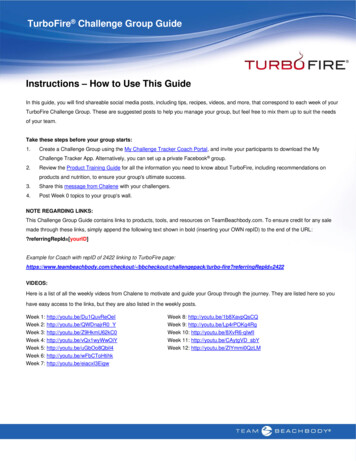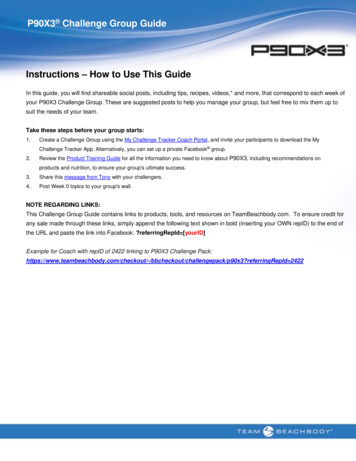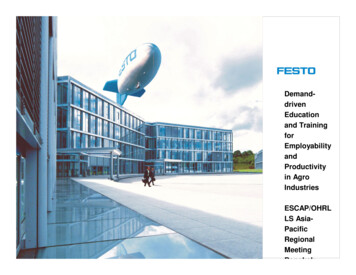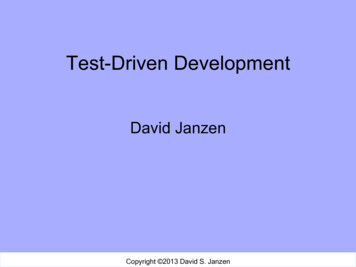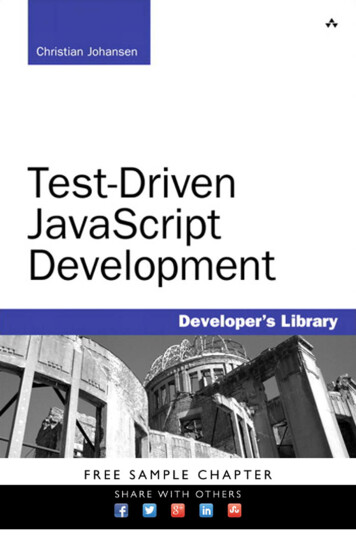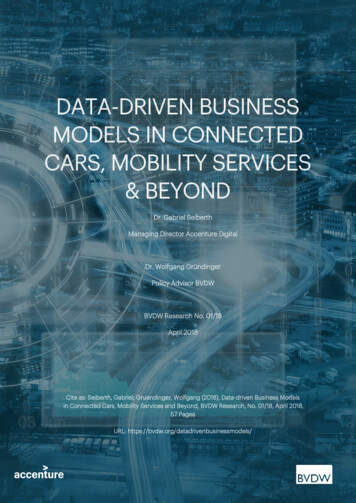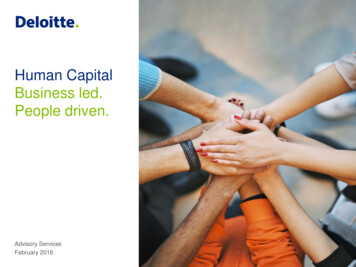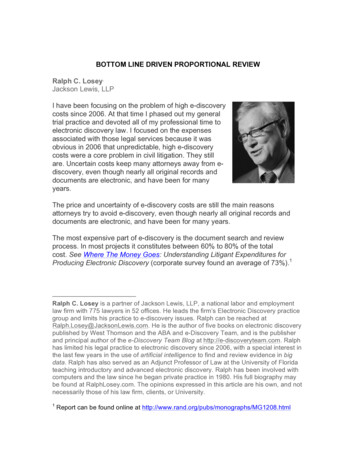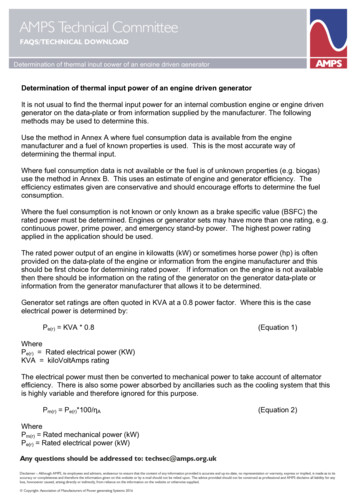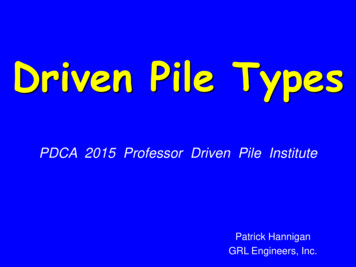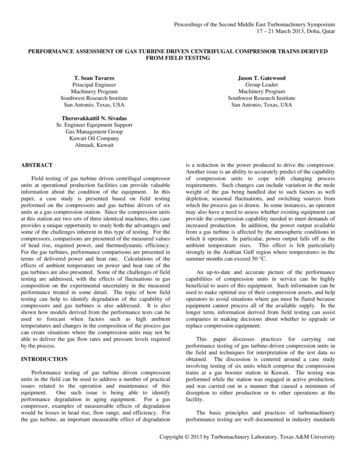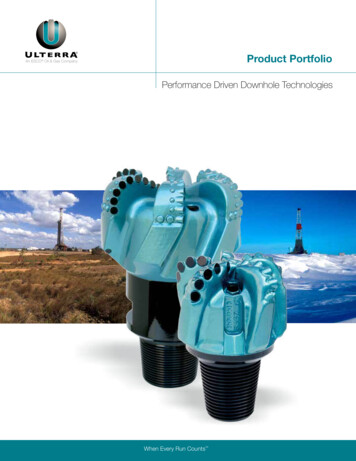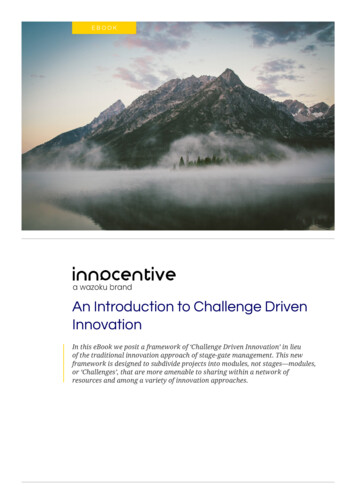
Transcription
EBOOKAn Introduction to Challenge DrivenInnovationIn this eBook we posit a framework of ‘Challenge Driven Innovation’ in lieuof the traditional innovation approach of stage-gate management. This newframework is designed to subdivide projects into modules, not stages—modules,or ‘Challenges’, that are more amenable to sharing within a network ofresources and among a variety of innovation approaches.
ContentsAn Introduction to Challenge Driven Innovation The InnoCentive Offering InnoCentive Challenge Examples InnoCentive Challenge Types Solver Spotlight p4p20p22p25p252
About Wazoku & InnoCentiveTogether, Wazoku & InnoCentive are your global home of innovation.Through our market-leading technology, proven methodologies andexpertise, and Open Innovation Marketplace, we empower organizationsto solve complex problems and continually drive innovation. AtInnoCentive, we have a long and rich history of being the global pioneerin crowdsourced innovation. Using our proven Challenge DrivenInnovationTM methodology, we help you to solve critical business,scientific and technical problems either by crowdsourcing the ideas andsolutions you need from our global network of highly educated problemsolvers or from their own internal networks. By accessing vast virtualworkforces across our entire Open Innovation Marketplace,organizations have worked with us to innovate faster, with less risk, andat a lower cost. To date, we have conducted over 2,000 externalChallenges and successfully solved complex problems for NASA, Darpa,Enel, Astra Zenica, and Novartis. None of this would be possible withoutthe right technology. Powered by the Wazoku platform, we use the latestAI-driven idea management technologies to run the entire ChallengeDriven InnovationTM process, empowering you to harness, curate andsurface innovation ideas to solve your most pressing challenges.Whether you’re looking to make continuous improvements, addressspecific business problems or completely innovate your business model,we can connect you with the right people, with the right ideas at the righttime.3
IntroductionA new framework for innovation should position leaders to understandboth why and how to extract value external to their organization. In thiseBook we posit a framework of ‘Challenge Driven Innovation’ in lieu ofthe traditional innovation approach of stage-gate management. This newframework is designed to subdivide projects into modules, not stages—modules, or ‘Challenges’, that are more amenable to sharing within anetwork of resources and among a variety of innovation approaches.We then go on to define a Challenge, explores why it works, discussesmechanisms by which a Challenge-based approach can be implementedas a core process, and offer a number of select examples. Then theChallenge Driven Enterprise is formally defined - an end-state visionfor organizations to drive innovation, agility, and better economics fordoing business in the 21st century. Challenge Driven Innovation is beingembraced by leaders across industry sectors – here we look across avariety of sectors, providing examples of Challenges from NASA, DOW,Thomson Reuters and GlaxoSmithKline .Open Innovation’s Unique PotentialArguments for open innovation often seem to hinge upon sentimentssimilar to those once expressed by technology investor Bill Joy of SunMicrosystems: “Most of the smart people work for someone else.” Youcan certainly agree to the truthfulness of this declaration. But thissimple observation does not provide any guidance on what to do aboutthat fact. Rather, you should ask the question, “What does the practiceof open innovation, the tapping of smart people who don’t work for you,do for your business that closed innovation cannot?” Answers to thatquestion would likely start with arguments for how open innovationbetter manages diversity and risk sharing.Damon Runyon said: “The race is not always to the swift nor the4
battle to the strong, but that’s the way to bet.” For most organizations,the act of hiring is an act of betting, and the smart money will bethe selection of “the swift and the strong.” But Runyon correctlyargues that the race might be won otherwise. And history showsits complete support for that contention. Was it not an Augustinianmonk, Gregor Mendel, who laid the foundations of genetics? Was itnot an academically unemployable patent clerk, Albert Einstein, whoshredded all assumptions about space time? Was it not a bookseller’sapprentice, Michael Faraday, who discovered many of the elementsof electromagnetism? No one is disputing the raw intellect of thesecontributors. One is merely acknowledging the likelihood that theyall would have failed the employment criteria in biology, cosmology,and telecommunications, respectively, even just before their seminalbreakthroughs. In many cases, in a highly specialized world, someonefrom another discipline, such as a physicist solving a biochemistryproblem, is the one who grabs the brass ring, or wins the race.Yet, the hinted-at, alternative employee recruitment strategyis completely untenable. Yes, the heat exchanger problem in aproduction plant might be best solved, not by a chemical engineer,but by a residential furnace technician, an automobile repair man,or a computer chip designer—or for that matter, an archaeologist, aveterinarian, or a maid. But so what? Surely there is no intention tohire all six of these individuals.just in case. And even less intentionof hiring the other 60 qualifications who might have been speculatedon in this paragraph. To do so would be an act of lunacy. Enter openinnovation.The merit of accessing talent from outside the prevailing disciplines isrecognized. Stan Davis and Chris Meyer, in their book Blur, suggest asone of “50 ways to blur your business” that you challenge the proclivityof Ivy League groupthink by hiring a “trade school grad with a guitarand a tattoo.” But, of course, capriciously hiring an “unqualified”cadre would be an abuse of resources. On the other hand, contractingwith them may indeed offer some viable alternatives. And this latterapproach holds an even greater likelihood of a favorable outcome ifthis work, or their contributions to it, could be done in parallel, withvalue assigned to the contribution only after the fact. Could that heatexchanger problem have been worked on simultaneously by thechemical engineer, the furnace technician, the auto repairman, ANDthe chip designer? And, after the fact, could the heat exchanger ownerhave reviewed the results and elected to pay for outcomes as opposedto efforts? Suddenly a “guitarist with a tattoo” is not only a challenge toour way of thinking but a viable way to actually get creative work done.In this scenario, you can see the role open innovation potentially playsin both diversity and risk-sharing: The contributors assume the riskthat their contribution may not be deserving of post-facto compensation5
commensurate with the effort undertaken. If this were the only wayopen innovation was designed to work, it would probably fail. Butrisk-sharing business models that provide access to diversity and selfselection mechanisms enable many of these benefits to be achieved in afair and equitable environment. So much so, that any organization thatrelies exclusively on the employment mechanism for accessing talent isguilty of under-serving its stakeholders.It was this central constraint of employment “bets”—the limitation thatclosed innovation was performed by those that had been interviewed,selected, and recruited even before the task was known—that led EliLilly to its original founding of InnoCentive and other open innovationsystems. Lilly wanted access to a greater diversity of approaches than itmade sense to acquire through hiring the many, many new employeesthat would have created that diversity internally. Many times the workto be carried out in an industrial setting is unlike any specific work anemployee has ever done before. How then is qualification determinedin order for work to be appropriately assigned? It is usually done on thebasis of broad skill sets. That is to say that computer programmers areassigned to learn and write in a new language. MBAs are assigned tomanage something they’ve never managed before. Solid state physicistsare asked to invent better hard drive materials. And marketers areasked to develop campaigns for products they only just discovered evenexisted. All of these are somewhat non-ideal. The employees assignedare roughly, but not ideally, qualified. They are what might be referredto a rational compromise.Exploring Problem-Solving DiversityConsider instead the well-publicized story of Goldcorp. Goldcorp ownedmining rights on about 55,000 acres near Red Lake in Northern Ontario.The founder and chairman at the time, Rob McEwen had listened tothe many perspectives on how and where the gold might be found ingreater quantities, yielding a higher overall mine productivity. WhileRob understood that a deep geological science lay at the root of theseconclusions, the variables were never perfectly controlled and theconclusions were based on assumptions and models as much a partof tradition as they were of rigorous objectivity. McEwen wanted totake a new tact. He proposed that the geological survey data be freelygiven to anyone seeking it in exchange for their hypotheses on wheregold might be more prevalent. To the person(s) providing the answerthat best panned out for Goldcorp’s efforts, they would award 575,000in prize money. The survey data was shared with over 1,000 groupsand individuals who were interested in tackling the effort. Proposalscame from all around the world and from many individuals outsidethe mining industry, and certainly from many who were not eventrained geologists. The winning entry was a collaborative effort by6
two groups from Australia: Fractal Graphics, in West Perth, and TaylorWall & Associates, in Queensland. The graphic methods they employedprovided an entirely new perception of the data and lead the Red Lakemine to become the most productive gold mine in history.A greater diversity of approaches to problems in commercial,philanthropic, or government endeavors would likely yield superiorsolutions, greater economic viability, and shorter innovation cycles—allof which would ultimately benefit both shareholders and customers.These are the issues that presently drive the adoption of openinnovation by the most successful innovators.Risk SharingWithin the innovation endeavor, risk rears its head in the form of:financial risk, having to pay for things before success is assured;technical risk, some ideas don’t actually work; and execution risk,it would have worked, but the endeavor was done ineffectively. Ina closed innovation system, all of these risks are borne solely bythe innovating organization. It must pay for projects whether theyultimately succeed or fail. In an open innovation system, these risksmay be shared with partners enabling their more effective managementand permitting risky portfolios to be increased in size—the samebudget will pay half the costs for twice as many projects— providingdiversification and lowering the risk of the portfolio yielding anexcessive number of failures. Even more significant than simply thesharing of risk is the observation that risk itself is asymmetrical. That is,the amount of risk offloaded by one party may be considerably greaterthan the amount of risk the other party assumes.In the incubation phase of InnoCentive, some pointed out that theassumption of risk by the Solver community was unsustainable. Sothe likelihood for Solver engagement was assessed during a prelaunchroadshow, as the founders met with various potential Solvers. Duringa meeting with Professor Tom Wandless at Stanford University, theoverall idea was outlined, and Professor Wandless was asked if hemight, under any circumstances, be willing to participate. His responsewas that he had grave doubts about whether he would ever evenconsider altering his research endeavors in response to a postedchallenge. But, he then added that one of his ongoing research interestswas the design of new synthetic routes to dehydroamino acids. He saidthat if one of the posted challenges needed such an effort, he mightbe willing to “put their compound in my table.” By this he meant thathe would consider adding an example to a table of examples in thework he was already doing. He added that, if a bounty was postedfor the solution, he would be willing to cash the check. He was sayingthat a posted challenge, looking for new ways to make dehydroamino7
acids was work he would be undertaking anyway, and it would be oflittle inconvenience to add to his efforts the specific research that thechallenge-posting company was “off-loading.” In essence, you aren’ttaking on more risk if you were going to do the work (or somethingclosely akin to it) anyway.“Dispersed physically butconnected by technology,workers are now able,on a scale never beforeINNOCENTIVEevenW O R imaginable,K S H O P S to maketheir own decisions usinginformation gathered frommany other people andplaces. For the first timein history, technologiesallow us to gain theeconomic benefits oflarge organizations, likeeconomies of scale andknowledge, without givingup the human benefits ofsmall ones, like freedom,creativity, motivation, andflexibility.Thomas MaloneWriting In: Future of WorkMIT Sloan School of ManagementA second way in which the off-loaded risk is of different magnitudethan the assumed risk by individual solvers is related to the assignmentprocess. The risk of innovating in a corporate setting must take intoaccount the issue raised earlier: that task allocation is inefficient andinvolves compromises—compromises that raise the financial risk asfailures accumulate and raise the execution risk as non-ideal executorscontribute to false negative conclusions. In some open models, thepersons tackling the problem self-select which helps further obviate thenon-ideal assignment of tasks. For these reasons and others, individualresearchers and small contract firms are often more than willing toaccept some risk and work without a guarantee of payment. This createsinnovation opportunities via external efforts that are simply impossiblewith closed innovation approaches alone.Historical Stage-Gate ProcessesThis global market and capabilities shift prompts speculation as to howan organization’s innovation framework and processes may evolvein accord with these broad changes. The current dominant paradigmfor internal innovation is the stage-gate process. Closed innovationis an inherently serial process. As this process has been subjected tothe scrutiny of corporate efficiency, it has been architected as a linearand ordered sequence of major stages separated by gates. For a typicalcircumstance, imagine five stages and four gates, with the final gatebeing the project’s admission into production and the marketplace.Although the words will frequently differ, a representative seriesof stages might be perceived as: idea, validation, proof of concept,prototype, and production. This arrangement is well-suited for aninternal, serial process, with gate-point checks and balances on viabilityand returns, and will undoubtedly survive to some degree even asopen innovation is more fully exploited. Alone, the stage-gate processfails to either effectively manage or fully capture the opportunitiespresented via “full” innovation: open plus closed. In an environmentwhere both modes of innovation are practiced, would this stage-gatemechanism still dominate? After all, open innovation can be decidedlyparallel, and that is a feature that should be exploited. Stages and gatesmanage cost containment by setting gate criteria such that projects thatbecome too risky, too likely to fail, are terminated before more money isspent on their development. But in open innovation, when those highrisk costs are assumed, or at least shared, by others, it is less critical8
that termination criteria be prematurely applied by passing throughfrequent gates or decision points. Although one would never argue forthrowing out some of the distinctive benefits of the stage-gate paradigm,you might argue for its cohabitation alongside other project paradigmsto organize the open innovation process.The alternative framework put forward at this time is Challenge DrivenInnovation (CDI). In CDI, a portion of the larger project is formulatedas a Challenge, in which a “Challenge” essentially represents theproblem statement for a block of work that can be modularized andin most cases rendered “portable.” That is, such a block of work canbe outsourced or insourced as an integral unit. The central processesto this framework are those of dissection, channel distribution, andintegration.Seven Stages of CDIBecause the stage gate framework is so generalizable, it might betempting to read the following as nothing more than a renaming ofthe stages. Try not to do so. These may be overlapping and iterate. Butmost important, the activities generally associated with the stage-gatemechanism are almost entirely conducted between activities number4 and number 5, where the default channel is to conduct the workinternally.1. Idea gathering: The open front-end of the innovation developmentfunnel. It is the gathering of more opportunities than you have thecapacity to manage so that the most promising can be selected formoving forward.2. Filtering: The selection of projects best-suited to development andmarketing by your organization. The culling of projects that eitherfail to meet targeted returns or do not fit strategically with corporateobjectives.3. Dissection: The decomposition of a large, complex project intodiscrete modules. These modules are larger than individual tasksbut considerably smaller than the overall project itself. They are ofa scale and properties that can be made modular; that is, they canbe executed according to recipe or end product specifications. Theycan be made portable and placed as an integral body of work tobe executed either internally or externally. Each of these modulesof an innovation can be characterized as a problem statement or“Challenge.”4. Channel distribution: The placement of the above work units, orchallenges, into the appropriate innovation channels. Innovationchannels include, but are not limited to, contract researchorganizations, academic projects and grants, joint ventures, and of9
course, internal efforts.5. Evaluation/confirmation: The receipt of the completed challengemodules from the channels to which they were distributed, andthe comparison of results against specifications and performancecriteria.6. Assembly and integration: The reassembly of the individualchallenge modules into a functional whole that is ready for market.7. Launch: The launch of the new product, concept, or service into themarket place.Figure 1.0 Dissecting a large project, distributing sub-projects into appropriate innovationchannels and reassembling the completed and evaluated segments into a whole formarket launch.10
Case Study: NASAParticipants from around the world, 579 of them, took a close look at the“Data-Driven Forecasting of Solar Events” Challenge on InnoCentive’swebsite. The problem was finding a suitable method to more reliablypredict the particle storms originating with solar events. Fourteencomplete proposed solutions were submitted. After reviewing them,NASA issued a success award to Bruce Cragin, a semi-retired radiofrequency engineer. Cragin holds a Bachelor of Science degree inengineering physics and a doctorate in applied physics. He has 15 years’experience in plasma physics basic research and another 13 years ofindustrial experience as a radio frequency engineer. The challenge was“right in the ‘sweet-spot,’” Cragin said, “Though I hadn’t worked in thearea of solar physics as such, I had thought a lot about the theory ofmagnetic reconnection. Also, the image an
problem, is the one who grabs the brass ring, or wins the race. Yet, the hinted-at, alternative employee recruitment strategy is completely untenable. Yes, the heat exchanger problem in a . production plant m
